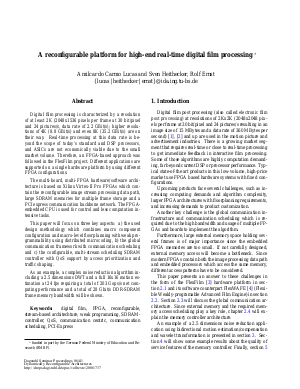FlexFilm - an Image Processor for Digital Film Processing
Authors Sven Heithecker, Amilcar do Carmo Lucas, Rolf Ernst
-
Part of:
Volume:
Dagstuhl Seminar Proceedings, Volume 6141
Part of: Series: Dagstuhl Seminar Proceedings (DagSemProc) - License:
 Creative Commons Attribution 4.0 International license
Creative Commons Attribution 4.0 International license
- Publication Date: 2006-10-09
File

PDF
DagSemProc.06141.9.pdf
- Filesize: 1.09 MB
- 11 pages
Document Identifiers
Subject Classification
Keywords
- Digital film
- FPGA
- reconfigurable
- stream-based architechture
- weak programming
- SDRAM-controller
- QoS
- communication centric
- communication scheduli
Metrics
- Access Statistics
-
Total Accesses (updated on a weekly basis)
0Document
0Metadata
Abstract
Digital film processing is characterized by a resolution of at least 2K (2048x1536 pixels per frame at 30 bit/pixel and 24 pictures/s, data rate of 2.2 GBit/s); higher resolutions of 4K (8.8 GBit/s) and even 8K (35.2 GBit/s) are on their way. Real-time processing at this data rate is beyond the scope of today's standard and DSP processors, and ASICs are not economically viable due to the small market volume. Therefore, an FPGA-based approach was followed in the FlexFilm project. Different applications are supported on a single hardware platform by using different FPGA configurations. The multi-board, multi-FPGA hardware/software architecture is based on Xilinx Virtex-II Pro FPGAs which contain the reconfigurable image stream processing data path, large SDRAM memories for multiple frame storage and a PCI express communication backbone network. The FPGA-embedded CPU is used for control and less computation intensive tasks. This paper will focus on three key aspects: a) the used design methodology which combines macro component configuration and macro-level floorplanning with weak programmability using distributed microcoding, b) the global communication framework with communication scheduling and c) the configurable, multi-stream scheduling SDRAM controller with QoS support by access prioritization and traffic shaping. As an example, a complex noise reduction algorithm including a 2.5 dimensions DWT and a full 16x16 motion estimation at 24 fps requiring a total of 203 Gops/s net computing performance and a total of 28 Gbit/s DDR-SDRAM frame memory bandwidth will be shown.
Cite As Get BibTex
Sven Heithecker, Amilcar do Carmo Lucas, and Rolf Ernst. FlexFilm - an Image Processor for Digital Film Processing. In Dynamically Reconfigurable Architectures. Dagstuhl Seminar Proceedings, Volume 6141, pp. 1-11, Schloss Dagstuhl – Leibniz-Zentrum für Informatik (2006)
https://doi.org/10.4230/DagSemProc.06141.9
BibTex
@InProceedings{heithecker_et_al:DagSemProc.06141.9,
author = {Heithecker, Sven and do Carmo Lucas, Amilcar and Ernst, Rolf},
title = {{FlexFilm - an Image Processor for Digital Film Processing}},
booktitle = {Dynamically Reconfigurable Architectures},
pages = {1--11},
series = {Dagstuhl Seminar Proceedings (DagSemProc)},
ISSN = {1862-4405},
year = {2006},
volume = {6141},
editor = {Peter M. Athanas and J\"{u}rgen Becker and Gordon Brebner and J\"{u}rgen Teich},
publisher = {Schloss Dagstuhl -- Leibniz-Zentrum f{\"u}r Informatik},
address = {Dagstuhl, Germany},
URL = {https://drops.dagstuhl.de/entities/document/10.4230/DagSemProc.06141.9},
URN = {urn:nbn:de:0030-drops-7377},
doi = {10.4230/DagSemProc.06141.9},
annote = {Keywords: Digital film, FPGA, reconfigurable, stream-based architechture, weak programming, SDRAM-controller, QoS, communication centric, communication scheduli}
}
